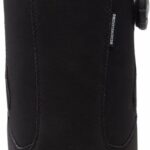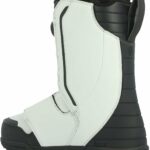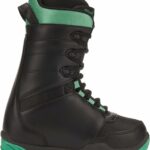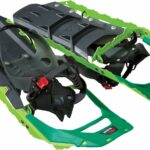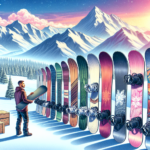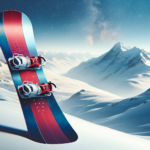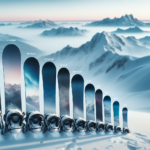Embarking on the thrilling world of snowboarding, you might find yourself asking – does snowboard size matter? Glide through this article and find out how the very dimensions of your board can dramatically impact your performance, from speed to stability. Discover the intricate relationship between your height, weight, and the size of your snowboard. As you explore this in-depth analysis, it will become clear why board size is an imperative consideration for every snowboarder, beginner, or pro.
Understanding Snowboard Sizes
If you’ve ever wondered, “Does snowboard size matter?” you’re about to get your answer. And the answer is a resounding yes. Snowboard size plays a pivotal role in how you glide, spin, stop, and enjoy your overall time on the slopes.
The role of height and weight in snowboard size
Both height and weight factor into determining the correct snowboard size. Your height helps determine the length of the board, while your weight is used to select the width. If you’ve got a heavier build, you’ll need a wider board to support your weight and give you control. Similarly, if you’re taller, you’ll need a longer board to match your stance.
What are the standard snowboard sizes?
Standard snowboard sizes range from 134 cm to 169 cm in length, with widths from about 24 cm to 26 cm. Keep in mind that these sizes aren’t set in stone; they’re just guidelines. Snowboards come in all sorts of different shapes and sizes, so you’ll have to find one that fits you well and matches your riding style.
Difference between men’s and women’s snowboard sizes
Men’s and women’s snowboards have their differences. Men’s snowboards are typically wider, longer, and have a stiffer flex to accommodate larger sizes and weight. On the other hand, women’s snowboards are narrower, shorter, and feature a softer flex to fit smaller frames and weights. While these are the norms, what’s most important is finding a board that fits you and your style of riding, regardless of the gender label.
Snowboard Size and Your Riding Style
Snowboard size can significantly impact your riding style and performance on the slopes. It influences control, speed, and maneuverability, making it crucial to pick the right size for your preferred riding style.
The effect of snowboard size on freestyle riding
For freestyle riding, where tricks, flips, and jumps are involved, smaller boards are often the better choice. They are lighter, more maneuverable, and easier to control in the air. A shorter board also provides you with quicker turns and easier spins, which are key in freestyle snowboarding.
How does snowboard size impact freeride and all mountain riding?
Freeride and all mountain riding generally require longer and wider snowboards. These provide better stability at high speeds and help you control your turns on varying slope conditions. Longer boards also offer more float in powder conditions, giving freeride and all mountain riders a smoother, more enjoyable experience.
Size considerations for backcountry snowboarding
When heading into backcountry terrain, where deep snow and variable conditions are the norm, you’ll need a longer and wider snowboard. This type of board provides the necessary floatation and stability to make your backcountry snowboarding adventure safer and more enjoyable.
Snowboard Size and Terrain
The terrain on which you will be snowboarding also plays a big role in determining the appropriate board size.
The influence of slope conditions on board size
Slope conditions can drastically affect the snowboard size you need. Hard, icy slopes require shorter boards for more control and maneuverability while soft, snowy slopes benefit from longer boards for greater stability and speed.
Board size for park and pipe riding
Park and pipe riders should generally opt for a smaller, more maneuverable board. The reduced size allows for easier spins, sharper turns, and better control in the air, which are all essential when navigating various obstacles in the park or pipe.
Making the right board size choice for off-piste terrains
Off-piste terrains call for longer and wider boards, as these provide better floatation in powder and improve stability on uneven terrains. However, keep your personal comfort and ability to control the board in mind when choosing a bigger board.
Choosing the Right Snowboard Size for Kids
Choosing the right snowboard size for kids is crucial to their safety, skill development, and enjoyment on the slopes.
Factors to consider when selecting kids’ snowboard size
Several factors come into play when choosing a snowboard size for kids. These include their height, weight, skill level, and type of terrain they’ll be riding on. A shorter, softer board is generally recommended for beginners as it’s easier to turn and control.
Adjusting board size as kids grow
As kids grow and their skills improve, they’ll need larger boards to accommodate their size and advanced skills. Regularly assess their snowboard size to ensure that it’s still appropriate for their continued development.
Safety considerations and board sizes for children
Safety is paramount when it comes to kids and snowboarding. Riding on a too-large board can be dangerously difficult to control, while a too small board may lack the necessary stability. Ensuring the right size snowboard will play a significant role in keeping your child safe on the slopes.
Snowboard Size and Skill Level
Your snowboarding skill level will significantly impact the size of the snowboard you need.
Board size for beginners – what you need to know
If you’re just starting out, a shorter board is typically easier to maneuver and control, making it a great choice. However, be sure to pick a board that’s not too short, as a very short board may lack stability and make it harder for you to learn.
Snowboard size adjustments as skill levels improve
As your skills progress, you may find yourself needing a larger board, especially if you’re getting into styles like freeride or all mountain. Be ready to reevaluate your board size and adjust as necessary to match your improved skills and expanded riding styles.
Board sizes recommended for expert riders
Expert riders should select their snowboard size based on their preferred riding style and the specific conditions they’ll be riding in. For a versatile and well-rounded option, a medium-length board is usually suitable, providing a good balance of control, stability, and maneuverability.
Binding Size and Snowboard Size
The size of your bindings is another major factor to consider when selecting a snowboard.
The relationship between binding size and board size
Ideally, your bindings should align with the edges of your board. If your bindings are too small, you may not have enough support to control your board effectively. Similarly, if they’re too large, they may overhang the edge of the board and interfere with your turns.
How incorrect binding size affects snowboard performance
Incorrect binding size affects board control, stability, and comfort. It may also cause unnecessary wear on your bindings and boots, affecting their durability. Always ensure you measure correctly for your binding size relative to your snowboard size.
Choosing the right binding size for your board
When choosing binding size, consider the width of your snowboard and the size of your boots. Also, check the manufacturer’s guidelines if available. The goal is to have bindings that perfectly align with the edges of your board and comfortably fit your boots.
Adjustments to Snowboard Size for Powder Days
Powder days can be the most thrilling times on the slopes, but they require some careful consideration when it comes to your snowboard size.
Why board size matters on powder days
On powder days, board size becomes extra important as it can drastically affect your floatation and control in deep snow. A longer, wider board will help you float better and avoid sinking into the powder.
Changes to board size for optimal powder performance
If you frequently ride in powder or plan to have a dedicated powder board, consider a longer and wider board than you typically ride. It will improve your floatation and allow you to ride smoother and faster.
Considerations for board length and powder snow
When it comes to board length and powder snow, longer is generally better. A longer board provides more surface area, which improves float in deep snow. But remember, you still need to be able to control your board, so don’t go too far beyond what you can comfortably handle.
Misconceptions about Snowboard Size
There are a few misconceptions about snowboard size that can lead you astray when selecting a board.
Myths about height and snowboard size
One common myth is that your snowboard should reach up to somewhere between your chin and nose when stood on its tail. While this is a good starting point, it’s not definitive. What matters more are your weight, foot size, and riding style.
Common misbeliefs about weight and board size
Another mistaken belief is that lighter riders should always choose smaller boards. While it’s true that smaller boards are easier for lighter riders to handle, board size should also be chosen based on ability level, riding style, and terrain preference.
Exploding the myth of ‘one size fits all’ in snowboarding
The idea of ‘one size fits all’ doesn’t apply to snowboarding. Every rider has unique needs and preferences, which means the perfect snowboard size varies from person to person.
Effects of Incorrect Snowboard Size
Choosing the wrong size snowboard can have a negative impact on your snowboarding experience.
How a too small board affects riding
A board that’s too small may lack stability, especially at higher speeds, and do poorly in powder snow. It can also be more difficult to land jumps and tricks.
Problems associated with riding a too large board
On the flip side, a board that’s too large can be difficult to turn and control, particularly for inexperienced riders. It may also feel heavy and unwieldy, which can make for a tiring day on the slopes.
The impact of incorrect size on snowboard control and maneuverability
In general, an incorrect snowboard size can significantly decrease your control and maneuverability on the slopes. Additionally, it can increase your risk of falls and injuries.
Snowboard Size Charts and Measurements
Using snowboard size charts and taking proper measurements can greatly assist you in finding the right board size.
Understanding snowboard size charts
Snowboard size charts are excellent tools that provide guidelines based on your weight, height, and sometimes foot size. While these charts don’t offer precise measurements, they are helpful in giving you a general idea of the board size range to consider.
How to measure for the right snowboard size
Accurate measurements are key to finding the perfect board size. Find your weight and match it against the snowboard size chart. Then do the same with your height by standing next to the board. If your measurement falls between two sizes, lean towards the shorter size for more freestyle riding, and a longer size for freeride.
Variables included in snowboard size calculations
Other variables included in snowboard size calculations can vary, but they typically take into account your weight, height, foot size, gender, skill level, and preferred riding style. Remember, these are only guidelines. Always try out the board in person whenever possible to ensure it feels right for you.
In conclusion, finding the right snowboard size involves a combination of factors. Weight, height, skill level, terrain, and riding style all play a role. By taking all of these into account, you’ll be able to make an informed decision and find the perfect board size for your unique snowboarding needs. Happy riding!
- What Snowboard Bindings Should I Get? - January 23, 2024
- What Size Screws For Snowboard Bindings? - January 23, 2024
- How To Snowmobile On Water? - January 23, 2024

